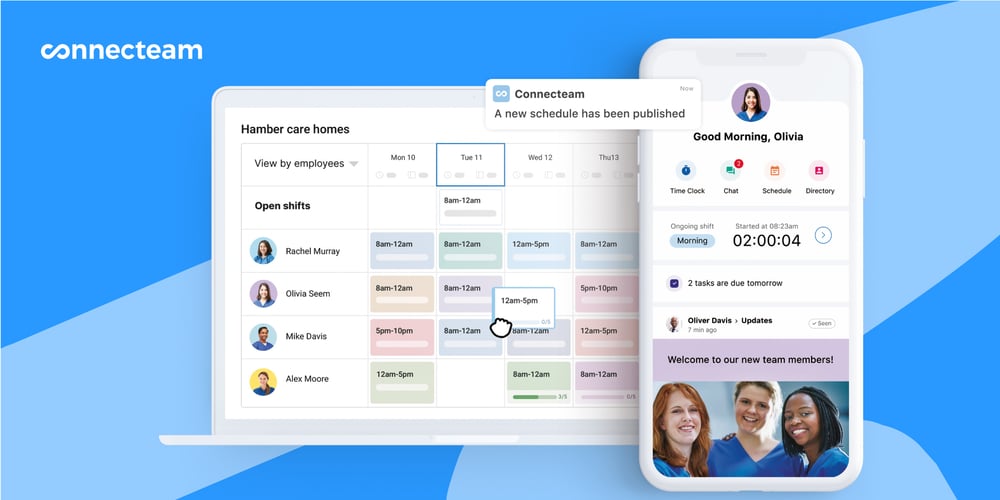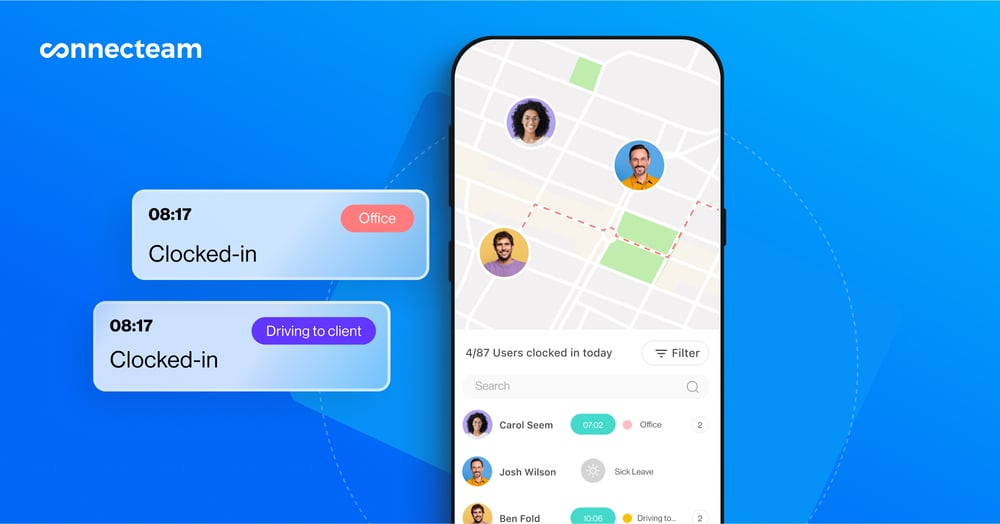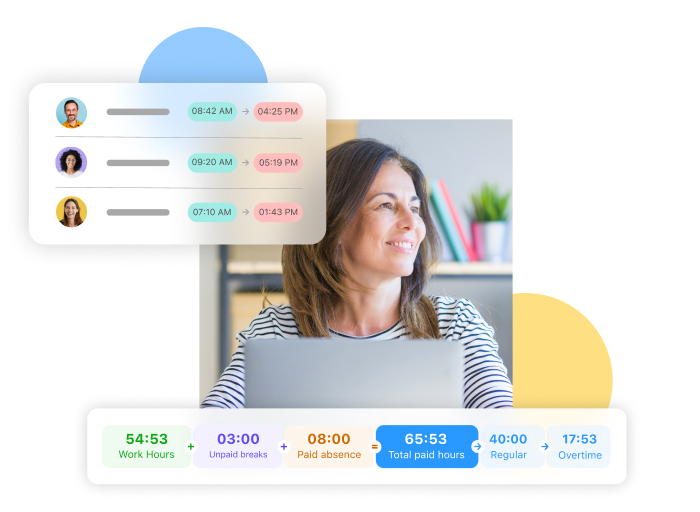Choosing the right workforce management platform can make or break your day-to-day operations.
Connecteam and Deputy are two popular tools in this space, but they offer very different experiences. Below, I break down their pros and cons to help you determine which one suits your team best.
A note about our method: Product comparisons and verdicts in this guide are based on hands-on testing by our expert team. All screenshots of Deputy were taken from real use during our evaluation.
At a Glance: Quick Summary
Connecteam is best known for its all-in-one mobile experience, making it a top pick for field-based teams that need everything from scheduling and time tracking to checklists and communication. Its free plan for small teams and built-in compliance tools make it especially appealing to growing businesses that want structure without high overhead.
Deputy stands out for its advanced scheduling engine, with AI-powered suggestions and detailed labor cost controls. It’s a strong option for operations that depend on shift optimization, real-time availability, and built-in compliance safeguards across multiple locations.
Pricing and Plans
Both Connecteam and Deputy offer subscription-based pricing models, but they have distinct approaches to their tiers.
| Plan Type | Connecteam | Deputy |
| Free Plan | ✅ Up to 10 users | ❌ |
| Starter | Basic $29/month for up to 30 users (+ $0.50 for each additional user) Includes time tracking, task checklists, forms, and team chat | Scheduling or Time & Attendance $4.50/user/month (each) Scheduling includes: • Employee scheduling • Auto-scheduling • PTO requests • Shift tasking Time & Attendance includes: • Timesheets • Payroll & POS integration • Leave management • Clock-in/out tracking |
| Pro | Advanced $49/month for up to 30 users (+ $1.50 for each additional user) Adds shift scheduling, kiosk clock-in, GPS, geofencing, and integrations | Premium $6/user/month Combines time tracking, scheduling, and reporting |
| Next tier | Expert $99/month for up to 30 users (+ $3.00 for each additional user) Adds auto-scheduling, unlimited shift tasks, and more | N/A |
| Enterprise | Enterprise Custom pricing | Enterprise Custom pricing |
| All prices shown are based on annual billing as of September 2025. | ||
Connecteam offers 3 main hubs: Operations, Communications, and HR & Skills. Each has its own set of features and pricing tiers, but the pricing structure remains the same across all hubs. The features in the table above are from the Operations Hub.
Instead of charging per user, Connecteam offers a base fee with an additional per-user fee, which I think is a great deal for midsize teams.
Deputy’s pricing gives you à-la-carte flexibility. You can choose just scheduling or just time tracking at $4.50/user/month. But for most teams, the full Premium plan at $6/user/month is where the real value kicks in. It combines both and unlocks shift swaps, labor compliance, and payroll integrations.
If your team needs only one function (say, just scheduling), Deputy might seem less costly. But for an all-in-one experience that scales affordably, I think Connecteam’s bundle pricing wins, especially for growing field teams juggling multiple workflows. For example, a team of 25 would pay $49/month total with Connecteam’s Advanced plan, while they’d pay $150/month for Deputy’s Premium plan.
Grow Your Team — Not Your Costs
Connecteam’s flat pricing scales with you. Get more features for less.
Pros and Cons
Both platforms are feature-rich, but no tool is flawless.
Connecteam pros ✅
- All-in-one mobile hub for deskless teams: From time tracking to task management to chat, everything lives in one app. I think that’s a huge win for teams that don’t want to juggle multiple tools.
- Free plan and flat pricing for up to 30 users: It offers excellent value for small teams, especially compared with platforms that charge per user for every user.
Connecteam cons ❌
- Setup depends on your team’s tech comfort: Getting everything dialed in properly depends on how familiar your team is with customizing workflows.
- Limited third-party integrations: While Connecteam offers a wide range of built-in tools, external integrations are currently somewhat limited.
Deputy pros ✅
- AI-powered scheduling and shift forecasting: These tools eliminate manual work by creating schedules for you based on sales, demand, and more.
- Built-in compliance templates: Deputy includes ready-made rules for labor laws like Fair Workweek laws. It’s especially useful for multi-location teams that need region-specific enforcement without manual setup.
Deputy cons ❌
- Limited real-time location tracking: While Deputy offers geofencing and GPS stamps at clock-in/out, it doesn’t provide continuous breadcrumb-style tracking.
- Steeper learning curve for new users: The interface is clean, but configuring advanced features like scheduling rules and compliance settings takes time.
Use Cases
Connecteam is best for:
- Centralizing shift-based workflows: Connecteam makes it easy to manage scheduling, time tracking, task assignments, and team communication all in 1 place.
- Mobile-first task management: Employees can check off tasks, upload photos, and complete custom forms directly from their phones, even during site visits or deliveries.
Deputy is best for:
- Smart, demand-based scheduling: Deputy’s AI-powered auto-scheduler and labor forecasting tools are excellent for building efficient weekly rosters.
- Enforcing labor law compliance: With built-in rules for breaks, shift caps, and certification checks, Deputy automates compliance.
Connecteam vs. Deputy: Side-by-Side Feature Overview
Both Connecteam and Deputy promise to simplify time tracking, scheduling, and team management. But how they deliver those features makes a big difference on the ground.
Employee scheduling & availability management – Winner: Tie
Connecteam functions as a scheduling app, making it easy to build and manage recurring and custom shifts with visual drag-and-drop tools. I love how you can assign shifts based on role, location, or tag, and the app supports templates for recurring weekly schedules. You can color-code by job type, filter by availability, and include shift-specific notes or attachments like checklists or training guides.
A standout is Connecteam’s auto-scheduling feature, which can pre-fill shifts based on qualifications, previous assignments, or availability, saving time during weekly planning. Employees can mark availability, request time off, claim open shifts, or swap shifts directly in the app, with customizable rules for manager approvals.
I appreciated how real-time alerts are triggered when someone’s a no-show, and how you can reassign shifts with 1 tap. For companies with rotating schedules or last-minute changes (like cleaning, security, or delivery crews), this helps avoid panicked phone calls and missed work. Employees can access their schedules from the mobile app and sync them with their calendars to stay on top of their shifts without needing to bother their managers.

Deputy brings equally strong scheduling tools, especially for businesses managing large hourly workforces. The AI-powered smart scheduler suggests optimal shift assignments based on availability, labor costs, fatigue rules, and sales forecasts.
What stood out to me was the Deputy’s newer location setting, which lets employees claim shifts even during their marked “unavailable” hours (if enabled by the manager). This means someone might mark themselves unavailable for regular scheduling but still be able to volunteer for last-minute coverage. This could benefit, say, a part-time worker who’s normally unavailable on Tuesday mornings but wants to pick up a shift if their plans change.
Deputy also offers shift swaps, offers, and self-service availability management, allowing team members to negotiate coverage without needing a manager to intervene each time.

Time tracking & location enforcement – Winner: Connecteam
Connecteam supports time tracking through mobile, web, and kiosk modes, so employees can clock in from the mobile app, a browser, or a shared tablet. When you have employees clock in through a shared device, you can require them to input personalized PIN codes or take selfies so they can’t clock in for each other.
Connecteam features a real-time GPS tracker, so you can verify clock-in locations, restrict clock-ins to specific geofenced areas, and track workers’ real-time locations with GPS breadcrumb tracking. I found this feature especially useful for seeing movement history during shifts.
You can also use “shift attachments” to collect information (like shift feedback, mileage, or equipment used) during clock-outs.

Deputy also does a solid job tracking time through multiple devices, including shared kiosks and mobile apps with GPS. The iPad kiosk captures photos of workers during clock-ins. Employees can also leave shift feedback during clock-out, which we found to be a nice morale touch.
However, Deputy provides only static location snapshots but not live GPS breadcrumbs. So you get a moment-in-time view rather than a holistic understanding of where employees move during their shifts. I think this might be fine for static job sites, but for mobile teams like cleaners, event crews, or delivery staff, it means less visibility and fewer accountability tools.

PTO & leave management – Winner: Connecteam
I find Connecteam’s time off management features surprisingly smooth. Employees can submit leave requests directly through the mobile app, whether for vacation, sick leave, or unpaid time off. Managers receive instant alerts, and approvals can be done in just a few taps.
What I really like? The system syncs those approvals with the schedule and timesheets, so you’re not manually cross-checking leave records later.
Connecteam also lets you customize leave types, set up blackout periods, and control who can request which type of time off. I found this helps prevent overstaffing and miscommunication before it happens, and employees can conveniently check remaining balances without bugging HR.
Deputy’s leave management system handles the basics well. Employees can submit requests and view remaining balances from the app, and managers can approve or deny them with notes.
However, when we tested this feature, we noticed an issue: If a manager doesn’t act on a leave request promptly, there’s no alert stopping them from assigning a shift on top of that pending request. Compare this with Connecteam, which automatically flags pending time off requests during scheduling, so managers are less likely to assign shifts that overlap with approved or awaiting leave.
Compliance – Winner: Tie
The Connecteam break management software allows managers to enforce break rules based on shift length and set alerts for missed breaks. Overtime rules can be customized according to your state laws (by day or week), and the system warns when employees are approaching limits.
You can even prevent clock-ins that would push someone into unauthorized overtime. One thing I found especially useful was how these rules show up in the scheduler and make it easier to catch issues before they happen.
I also liked the automatic break deduction feature. If someone forgets to clock out for a meal break, the system adjusts the timesheet automatically, reducing payroll corrections.

Deputy’s compliance features include break rules, fatigue management, and overtime alerts. These tools work well, but configuring them takes time. That said, the fatigue management settings, which let you set limits on hours, days, and rest periods, are pretty unique for workforce management software.
It also includes built-in compliance templates for laws like Fair Workweek, New York City scheduling rules, and California break requirements, which is a big advantage for teams operating across strict labor jurisdictions.
Deputy’s break planning tools allow you to set automatic unpaid break deductions based on shift length.
We appreciated the alerts Deputy sends when a shift assignment risks triggering overtime or violating scheduling limits.
Task management & checklists – Winner: Connecteam
I used the Connecteam task management app to assign jobs across locations, attach photos or forms, and set deadlines. What really stood out was the ability to track task completion in real time, which helps you stay on top of recurring operational processes without micro-managing.
Even better, Connecteam lets you create customizable checklists for everything from opening procedures to safety inspections. You can add time stamps and required signatures, or even make completion mandatory before clocking out. I think that’s a big win for industries like hospitality, security, or cleaning, where missed steps can lead to costly oversights.
Deputy’s “tasking” feature is basic and fine for lightweight items like reminding someone to call a client or sanitize a workstation. However, unlike Connecteam, Deputy doesn’t have true checklist templates or detailed progress tracking. You can assign tasks, but you won’t get the same depth in terms of task history, attachments, or completion enforcement, which I find limiting.

Shift Into Action With Built-In Tasks and Checklists
Stay on track and on schedule with Connecteam’s task lists and forms.
Communication tools – Winner: Connecteam
Connecteam makes internal communication feel intentional with a central hub that blends real-time updates with structured knowledge sharing.
- The updates feature lets you post announcements and track who saw them, which is great for accountability.
- The online team chat supports both 1:1 and group conversations, creating a business-only space that doesn’t bleed into personal WhatsApp threads.
- The directory helps team members quickly find contacts without needing to message a manager.
Deputy’s communication tools are decent, but I feel that they’re not as developed. The newsfeed works well for sharing team updates, for instance. When we tested the platform, our tester found that while she could use the newsfeed feature for private messaging, the lack of a chat-like interface made it feel less private. There is a messaging feature that’s “coming soon,” but for now, real-time collaboration is limited.

HR & training tools – Winner: Connecteam
Connecteam stands offers complete HR and employee training software with the HR & Skills hub. I appreciated how intuitive it was to build onboarding courses with interactive lessons, track employee progress, and assign quizzes to ensure policy understanding.
Beyond training, Connecteam includes document storage, employee recognition and rewards, digital ID cards, surveys, and visual org charts. These features align your staff members and boost their morale and morale.
Deputy offers HR functionality through a separate paid module called Deputy HR. It covers structured onboarding with document assignments, e-signatures, and task tracking. We found it well-organized for setup and admin needs.
However, it focuses more on paperwork than people development. There’s no in-app training builder or quiz tracking, and it doesn’t feel as tailored to mobile-first workflows. For deeper employee development, it falls short.
Integrations – Winner: Deputy
Connecteam integrates smoothly with accounting tools like QuickBooks, Xero, Gusto, and Paychex. Plus, integrations with tools like Lightspeed POS and Wix Bookings can be especially handy for retail and service-based businesses.
While the native integration list isn’t huge, Connecteam makes up for it with Zapier access and open API support on higher-tier plans.
Deputy has a broader native integration ecosystem. It connects with Gusto, ADP, Square, and BambooHR, and more. Its tight integrations with payroll and point-of-sale systems is a major strength for businesses in hospitality, healthcare, and retail.
Mobile experience – Winner: Tie
Connecteam’s mobile app is one of the most polished workforce apps I’ve tested. The interface is clean, fast, and clearly built for real-world use. Employees can clock in/out, view schedules, chat with teammates, complete checklists or forms, and access training from their phones. Meanwhile, admins can assign shifts, review logs, approve time off, send announcements, and more, even while offsite.
We tested Deputy’s app and found it just as responsive and intuitive. It shines for its scheduling: Employees can view shifts, claim open ones, swap with coworkers, and get push alerts for last-minute changes to reduce no-shows, while admins can manage leave, edit shifts, and check who’s on-site.
Overall usability – Winner: Connecteam
Connecteam puts usability front and center. The interface is clean, with navigation built around real workflows like scheduling, forms, and communication. The UI avoids jargon and keeps tasks logically grouped. Employees get the same simplicity through a widget-style home screen showing only what matters: shifts, tasks, forms, and unread chats.
Deputy also offers a sleek experience, especially for shift tasks like clocking in, checking schedules, or requesting time off. But a few things slowed us down when we tested it: Some admin tools were hard to locate, and employees had to click through multiple steps just to adjust availability.
User Ratings
Both Connecteam and Deputy earn strong ratings across major review sites, but Connecteam’s scores come from a significantly larger user base.
Connecteam
Deputy
Security & Compliance
| Category | Connecteam | Deputy |
| Data Encryption | ✅ HTTPS encryption in transit | ✅ HTTPS encryption in transit |
| GDPR Compliant | ✅ | ✅ |
| Hosting Region | US, Australia, Israel, European Economic Area (EEA) | US, Australia, and EU |
| Admin Controls | ✅ (role-based access, audit logs) | ✅ (role-based access, custom user permissions, audit logs) |
| 2FA Available | ✅ | ✅ |
| Certifications (SOC 2, ISO, HIPAA) | ✅SOC 2, ISO 27001, HIPAA | ✅ SOC 2–aligned, GDPR compliant, no HIPAA |
When it comes to security, Connecteam stands out by supporting HIPAA, SOC 2, and ISO 27001. Its EEA hosting, GDPR/CCPA alignment, and audit logs give peace of mind that data is protected and traceable, even during disputes or audits.
Deputy ticks most of the core boxes like HTTPS encryption, 2FA, and role-based controls, and it’s solid for general use. But for companies needing HIPAA compliance, deep audit trails, or flexible hosting across regions, I think it falls short.
If your team operates in regulated environments or across borders, I’d recommend Connecteam for its more future-proof compliance setup.
Setup and Onboarding
I had no trouble getting started with Connecteam. The setup was smooth and well-guided, with a checklist that walked me through adding users, roles, and modules like time tracking or scheduling. I liked how modular it felt: It let me focus only on what I needed without the rest getting in the way.
There’s also a built-in training center with short, useful videos for admins and employees to onboard at their own pace.
When we tested Deputy, the experience was equally smooth. The onboarding wizard quickly helped us configure locations, teams, and shift rules. We appreciated how it nudged us to set permissions early, making access more structured from day one.
Support and Customer Service
Both Connecteam and Deputy offer great multi-channel support.
| Support Type | Connecteam | Deputy |
| 24/7 Chat | ✅ | ✅ |
| Phone Support | ✅ (Paid tiers via Connecteam Pros partners) | ✅ (Enterprise plans only) |
| Email Support | ✅ Free and paid tiers | ✅ Free and paid tiers |
| Help Center & Docs | ✅ Extensive and well-structured | ✅ Good but less in-depth than Connecteam |
| Live Onboarding Help | ✅ (With certified partners on Pro plans) | ❌ (Guides only; no dedicated onboarding) |
| Dedicated Account Manager | ✅ (Paid support) | ✅ (Enterprise only) |
Connecteam makes support feel accessible and dependable, even on the free plan. I’ve consistently gotten helpful responses via live chat and email, often within minutes. The help center includes step-by-step guides, videos, and templates for everything from scheduling to form setup.
What truly stands out is the Connecteam Pros service. For an hourly rate, you’re connected to certified experts for hands-on onboarding and tailored guidance—something I’d recommend if you’re switching from spreadsheets or scaling fast.
Deputy was also responsive during our tests. We submitted 2 tickets and heard back within an hour each time. Live chat begins with a bot, but reaching a real agent is easy. The help and learning centers cover common issues well.
However, we did hit a few snags when we tested it. Phone support wasn’t clearly listed, and the “book time with an expert” link led to an expired Zoom session.
🏆 Who Wins: Connecteam or Deputy?
| Choose Connecteam if you… | Choose Deputy if you… |
|---|---|
| Want a true AI scheduler that automatically builds optimized shifts based on rules, availability, and qualifications. | Want a basic smart scheduling algorithm with labor-cost controls and simple demand-based suggestions. |
| Need an all-in-one mobile platform with time tracking, scheduling, task checklists, chat, and HR tools in one app. | Already have separate tools for tasks, messaging, and HR and mainly need a standalone scheduler/time tracker. |
| Prefer a free plan for up to 10 users and flat, predictable pricing for growing teams. | Don’t mind paying per user for each module and prefer à-la-carte pricing. |
| Want real-time GPS breadcrumbs for full visibility into mobile workers, not just clock-in snapshots. | Manage mostly static job sites where one-time location stamps are enough. |
| Need strong compliance & PTO controls with blackout days, custom break rules, and automatic overtime tracking. | Want built-in labor law templates to quickly apply pre-set rules across locations. |
| Value exceptional support and guided onboarding, even on the free plan. | Have an internal admin team to configure and manage more complex scheduling rules. |
| Learn more about Connecteam | Read our in-depth Deputy review |
Both Connecteam and Deputy are excellent workforce management platforms, but they serve slightly different priorities.
Deputy shines for large organizations with highly complex scheduling needs, especially in industries like retail and hospitality where AI-powered forecasting and labor-cost controls are essential. Its built-in compliance templates and smart rostering tools can save time for managers who need to juggle hundreds of shifts across multiple locations.
Connecteam, on the other hand, gives you a complete all-in-one experience at a fraction of the cost. It combines time tracking, scheduling, checklists, communication, and HR tools into one mobile-first app.
That means your team can clock in, view shifts, complete tasks, message coworkers, and even take training—all from a single interface. Add in its generous free plan for up to 10 users, flat-rate pricing, real-time GPS tracking, and HIPAA-level security, and Connecteam becomes especially appealing for small to mid-sized businesses that need an affordable, scalable platform without sacrificing compliance or usability.
👉 The verdict: Choose Deputy if you manage a large, multi-location workforce and want deep AI scheduling and labor forecasting.
But if you’re looking for a cost-effective, mobile-friendly solution that centralizes scheduling, time tracking, compliance, and communication in one place, Connecteam is the clear winner.
Get started with Connecteam for free today!
FAQs
Is Deputy a CRM?
No, Deputy isn’t a CRM. It’s a workforce management tool focused on employee scheduling and time tracking. It doesn’t include sales or customer relationship management features.
Is the Deputy app safe?
Yes, Deputy follows modern security practices, including data encryption and role-based access. It’s hosted on secure cloud infrastructure and offers features like audit logs for added safety.
Is Connecteam an HRIS?
Connecteam includes several HRIS-like features, such as onboarding, documents, time off, and training, but it’s not a full-scale HRIS. It’s better suited for teams that need practical, mobile-friendly HR tools without complex payroll or benefits admin.
Is Connecteam really free?
Yes, Connecteam offers a comprehensive free plan for up to 10 users.

